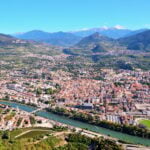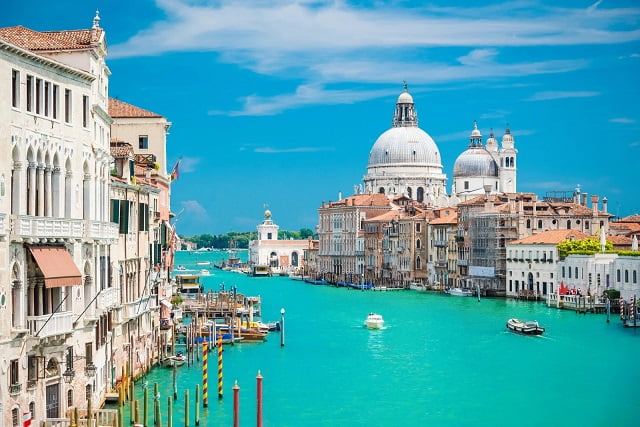Italy is a country known for its rich history, stunning landscapes, and vibrant culture. For many people, the idea of traveling from Ireland to Italy is an exciting prospect.
Whether it’s strolling through the streets of Rome, marveling at the art in Florence, or indulging in the delicious cuisine of Naples, Italy offers a diverse range of experiences for travelers. In this article, we will explore the possibility of traveling from Ireland to Italy, including interesting facts about travel between the two countries and the importance of proper planning before embarking on your journey.
One intriguing aspect of traveling between Ireland and Italy is their historical ties and cultural connections. Despite being geographically distant, these two countries have long-standing relationships that date back centuries. From shared influences in religion to significant migration patterns, Ireland and Italy have interwoven histories that make for fascinating exploration. Building upon this connection can enhance your travel experience by delving into the cultural nuances that unite these nations.
However, before boarding a plane or packing your bags, it’s crucial to take into account various entry requirements and travel restrictions. Understanding current visa regulations for Irish citizens traveling to Italy is essential to ensure a seamless trip.
Additionally, with COVID-19 still impacting travel worldwide, it’s vital to familiarize yourself with any specific guidelines or restrictions related to the pandemic. As always when visiting a foreign country, having all necessary documentation and paperwork in order is vital for entry.
Entry Requirements and Travel Restrictions
Current visa regulations for Irish citizens traveling to Italy
Under the current visa regulations, Irish citizens do not require a visa to travel to Italy for short stays of up to 90 days. This is due to both countries being members of the European Union and participants in the Schengen Agreement. As long as your visit is for tourism or business purposes and does not exceed 90 days, you can enter Italy with just a valid Irish passport.
However, it is important to note that this information may change, especially considering the evolving post-Brexit landscape. Therefore, it’s always advisable to check with the relevant authorities or consult the official website of the Embassy of Italy in Ireland for the most up-to-date information regarding visa requirements.
COVID-19 travel restrictions and guidelines
In light of the COVID-19 pandemic, there are currently some travel restrictions and guidelines in place for those traveling from Ireland to Italy. It is crucial to stay informed about these restrictions before planning your trip.
Currently, Italy has implemented a traffic light system organizing countries into different categories (green, orange, red) based on their level of risk. Travelers arriving from green list countries are not subject to quarantine or testing requirements.
Ireland is currently categorized as an ‘orange’ country on this list, which means that travelers from Ireland must present proof of vaccination or negative COVID-19 test results upon arrival in Italy. Additionally, travelers may be required to self-isolate for five days and undergo another COVID-19 test at the end of this period.
It’s worth noting that these regulations can change frequently due to updates in case numbers and government policies. Therefore, it’s important to regularly check official government websites or consult with your airline or travel agent before embarking on your journey.
Documentation and paperwork needed for entry
When traveling from Ireland to Italy, it is important to ensure that you have all the necessary documentation and paperwork for entry into the country. The following are some essential documents to consider:
- Valid passport: Ensure that your Irish passport is valid for at least three months beyond your intended stay in Italy.
- Proof of accommodation: It may be required to provide proof of pre-booked accommodations, such as hotel reservations or confirmation from a host.
- Return ticket: It is advisable to have a return or onward ticket to demonstrate that you do not intend to overstay your visa-free period.
- Travel insurance: While not mandatory, having travel insurance that covers medical expenses and trip cancellations can provide peace of mind during your journey.
- COVID-19 related documents: Due to the ongoing pandemic, you may need to show proof of vaccination, negative test results, or other health-related documentation upon arrival in Italy. Be sure to check the specific requirements before traveling.
By ensuring that you have all the necessary documentation and meet the entry requirements, you can enjoy a smooth and hassle-free journey from Ireland to Italy.
Modes of Transportation
When considering traveling from Ireland to Italy, one of the first decisions to make is how to get there. Thankfully, there are several modes of transportation available for this journey.
The most common and convenient option is to fly from Ireland to Italy. There are numerous flights offered by various airlines, providing travelers with flexibility in terms of departure and arrival times. Flying also allows for quicker travel compared to other methods, making it an ideal choice for those who want to reach their destination swiftly.
However, if you prefer a more scenic and leisurely journey, alternative travel options such as trains or ferries can also be considered. Taking a train through Europe offers a unique opportunity to appreciate the picturesque landscapes along the way. Similarly, traveling by ferry allows you to enjoy breathtaking views of the Mediterranean Sea during your voyage.
| Mode of Transportation | Advantages | Disadvantages |
|---|---|---|
| Flying | – Fastest option\n – Wide selection of flights\n – Convenient for long distances | – Can be expensive depending on booking time\n – Limited baggage allowance |
| Train | – Scenic routes\n – Comfortable seating\n – Opportunity for sightseeing during the journey | – Longer travel time\n – Limited availability of train routes from Ireland directly into Italy\n – May require multiple transfers |
| Ferry | – Beautiful views during the crossing\n – Chance to relax and enjoy onboard amenities\n – Possibility of bringing a vehicle | – Can be time-consuming, particularly for longer distances\n – Limited departure ports and routes |
Ultimately, the choice of transportation depends on personal preferences, budget constraints, and the level of adventure you seek. It is recommended to weigh the advantages and disadvantages of each mode and consider factors such as cost, travel time, comfort, and overall experience before making a decision.
Regardless of which mode of transportation you choose, embarking on a journey from Ireland to Italy promises an exciting adventure filled with new experiences and cherished memories. Whether you prefer the speed and convenience of flying or the scenic route offered by trains or ferries, it’s important to plan your itinerary accordingly to make the most out of your trip.
Best Time to Travel
When planning a trip from Ireland to Italy, it is important to consider the best time to travel in order to make the most of your experience. The timing of your visit can greatly impact the weather, availability and affordability of transportation options, as well as the overall tourist crowds in Italy. By choosing the right time to travel, you can maximize your enjoyment and create lifelong memories.
Weather considerations play a significant role in determining when to travel from Ireland to Italy. Italy experiences a Mediterranean climate with distinct seasons. The summer months of June, July, and August are characterized by hot temperatures and vibrant coastal scenes. However, this is also the peak tourist season with larger crowds and higher prices. If you prefer milder temperatures, spring (April-May) or autumn (September-October) are great times to explore Italy while avoiding excessive heat and masses of tourists.
Another factor to consider when determining the best time to travel is the availability and affordability of flights or other modes of transportation. During peak tourist seasons, flights tend to be more expensive and may require advanced booking due to high demand. Additionally, alternative modes of transportation such as trains or ferries may have limited schedules or higher fares during certain times of the year.
To make the most of your trip from Ireland to Italy, it is essential to choose a time that aligns with your preferences. If you enjoy lively festivals and cultural events, plan your visit during specific dates when regions or cities celebrate their unique traditions. Alternatively, if you prefer quieter exploration and sightseeing without large crowds, aim for shoulder seasons like spring or autumn.
Exploring Italian Regions and Cities
Italy is known for its rich history, stunning landscapes, and vibrant cities, making it a popular destination for travelers from around the world. When traveling from Ireland to Italy, there are numerous regions and cities worth exploring. From the historical wonders of Rome to the romantic canals of Venice, each location offers its own unique cultural experiences and attractions.
Overview of Different Regions and Cities in Italy
Italy is divided into distinct regions, each with its own characteristics and attractions. The northern region of Lombardy is known for its cosmopolitan city of Milan, as well as picturesque lakes such as Lake Como and Lake Garda. Tuscany, located in central Italy, boasts charming towns like Florence, Pisa, and Siena, where art and history intertwine.
Southern Italy offers a completely different experience with its ancient ruins in Pompeii and Herculaneum near Naples. The enchanting Amalfi Coast with its colorful cliffside towns is also a must-visit destination. In addition, the island of Sicily showcases beautiful landscapes, including Mount Etna and historic sites like the Valley of the Temples.
Popular Tourist Destinations and Hidden Gems
When planning your trip from Ireland to Italy, it’s essential to consider both popular tourist destinations and hidden gems off-the-beaten-path. Rome is an obvious choice with iconic landmarks such as the Colosseum, St. Peter’s Basilica, and the Vatican Museum. Venice captivates visitors with its romantic gondola rides through winding canals while Florence showcases magnificent Renaissance architecture.
However, there are also lesser-known treasures waiting to be discovered in Italy. For example:
- In Liguria on the Italian Riviera lies Cinque Terre: a collection of five colorful coastal villages connected by hiking trails.
- The island of Capri in the Bay of Naples offers breathtaking views from its rugged cliffs and the famous Blue Grotto.
- The region of Puglia in southern Italy is home to the enchanting trulli houses in Alberobello and stunning beaches along the Adriatic coast.
Unique Cultural Experiences and Attractions
Immersing oneself in Italian culture is a must-do while traveling from Ireland to Italy. Indulge in mouthwatering cuisine, sample regional wines, and experience lively local traditions. In Naples, savor authentic Neapolitan pizza straight from brick ovens while in Bologna, taste the renowned tortellini and tagliatelle at traditional trattorias.
For art enthusiasts, visit the Uffizi Gallery in Florence to see masterpieces by Botticelli, Michelangelo’s David at the Accademia Gallery, or admire Leonardo da Vinci’s Last Supper in Milan. Moreover, attending an opera performance at La Scala or an outdoor concert under the stars can provide unforgettable cultural experiences.
Planning Your Itinerary
When it comes to planning your itinerary for a trip from Ireland to Italy, there are several factors to consider. From the duration of your trip to the must-visit destinations, careful planning can help ensure that you make the most of your time in Italy.
Firstly, it is important to determine the recommended duration for your trip. This will depend on how much time you have available and how many places you want to visit. While some travelers may only have a week or two, others may have more flexibility with their schedule.
It is worth noting that Italy offers so much to discover that it can be difficult to see everything in one visit. However, with proper planning and prioritizing, you can create an itinerary that allows you to experience the highlights of this beautiful country.
Next, think about which regions and cities in Italy are at the top of your must-visit list. From bustling Rome with its ancient ruins and world-class museums, to the romantic canals of Venice and the picturesque coastlines of the Amalfi Coast, Italy has something for every type of traveler. Consider what interests you most – whether it’s art and history, food and wine, or breathtaking natural landscapes – and plan your itinerary accordingly.
Once you have determined which destinations you want to include in your itinerary, consider how much time you want to spend in each location. While some cities may warrant a longer stay due to their size and abundance of attractions, others may only require a day or two. Factor in travel time between cities when deciding how many days you would like to spend in each place.
By carefully crafting your itinerary based on your interests and time constraints, you can create a well-rounded trip from Ireland to Italy that allows you to make lifelong travel memories. Remember that flexibility is key when traveling; unexpected opportunities may arise along the way that could lead you off the beaten path. Embrace those moments as they come, and enjoy the excitement of exploring Italy from Ireland.
Accommodation and Budgeting
When planning a trip from Ireland to Italy, one important aspect to consider is accommodation and budgeting. Accommodation options in Italy vary greatly, ranging from luxurious hotels in popular tourist destinations to budget-friendly hostels and vacation rentals. Finding the right type of accommodation that fits your travel style and budget is essential for a comfortable and enjoyable trip.
For those traveling on a tighter budget, hostels can be an excellent option. They provide affordable accommodation while also giving you the opportunity to meet fellow travelers from around the world. Many hostels offer shared dormitory-style rooms as well as private rooms at a slightly higher cost. It is important to book in advance, especially during peak tourist seasons, to ensure availability.
If you prefer more privacy or are traveling with family or a group of friends, there are also plenty of vacation rentals available throughout Italy. Websites such as Airbnb offer a wide range of options, from apartments in city centers to charming countryside villas. Vacation rentals can often be more cost-effective than hotels, especially for longer stays.
For those who desire a more traditional hotel experience, there are numerous options available in all price ranges. Italy is known for its beautiful boutique hotels as well as internationally recognized chains. When booking accommodations, keep in mind that prices can fluctuate depending on the time of year and location.
In terms of budgeting for your trip, it’s important to research the average costs associated with traveling within Italy. This includes expenses such as transportation between cities, meals at restaurants, entrance fees for attractions, and any activities or tours you plan to participate in. By having a clear understanding of these costs beforehand, you can better calculate your overall budget for your trip.
It is worth noting that certain areas in Italy may be more expensive than others. Major tourist cities like Rome or Venice tend to have higher price tags compared to smaller towns or regions further off the beaten path. To save money, consider exploring lesser-known destinations or opting for day trips from your base location.
By carefully considering accommodation options and budgeting wisely, you can make the most of your trip from Ireland to Italy without breaking the bank. Remember to keep track of costs throughout your journey to ensure you stay within your budget. With proper planning and research, you can have a memorable and enjoyable experience in the beautiful country of Italy.
Can I Travel to Italy from Ireland? Absolutely. By taking the time to plan your accommodations and budget, you’ll be well-prepared for an incredible journey across this fascinating European country.
Safety and Security Tips
When traveling from Ireland to Italy, it is crucial to prioritize your safety and security throughout your journey. By being prepared and aware of potential risks, you can ensure a smooth and enjoyable experience in this beautiful country.
To start, it is important to familiarize yourself with general safety guidelines for traveling in Italy. This includes keeping an eye on your personal belongings at all times, especially in crowded tourist areas, as pickpocketing can occur. It is also advisable to avoid displaying valuable items openly and to be cautious when accepting help from strangers.
Unfortunately, tourist scams can happen anywhere, and Italy is no exception. To protect yourself from falling victim to common scams, such as fake charity collectors or overly persistent street vendors, it is essential to stay alert and trust your instincts. Remember that reputable businesses will not pressure you into purchasing their products or services.
In case of any emergencies or unforeseen situations during your trip, it is crucial to have access to the necessary resources. Save the contact information for the Irish Embassy or Consulate in Italy, as they can provide assistance when needed. Additionally, consider obtaining travel insurance that covers medical expenses and emergency evacuations to give you peace of mind throughout your journey.
Remember that traveling should be an enjoyable and fulfilling experience. By taking these safety precautions into account and remaining vigilant throughout your trip, you can fully immerse yourself in the wonders of Italy without unnecessary worry.
- Familiarize yourself with general safety guidelines for traveling in Italy.
- Be cautious of pickpocketing especially in crowded tourist areas.
- Avoid displaying valuable items openly and be cautious when accepting help from strangers.
- Protect yourself from falling victim to common scams by staying alert and trusting your instincts.
- Save the contact information for the Irish Embassy or Consulate in Italy.
- Obtain travel insurance that covers medical expenses and emergency evacuations.
Conclusion
In conclusion, the dream of traveling from Ireland to Italy is an exciting opportunity that should not be missed. With their historical ties and cultural connections, these two countries offer a unique travel experience that can create lifelong memories. However, before embarking on this journey, it is crucial to conduct proper planning and research.
As discussed in this article, entry requirements and travel restrictions are important factors to consider when traveling from Ireland to Italy. It is essential for Irish citizens to understand the current visa regulations and COVID-19 travel guidelines. Additionally, having the necessary documentation and paperwork ready for entry is crucial to ensure a smooth travel experience.
When it comes to modes of transportation, there are various options available. Flights from Ireland to Italy are a popular choice due to their convenience and time efficiency. However, alternative options such as train or ferry can provide a unique travel experience with the opportunity to enjoy scenic views along the way. Each mode of transportation has its pros and cons, so careful consideration should be given based on personal preferences and requirements.
Choosing the best time to travel is another important aspect that can greatly enhance one’s trip. Considering weather conditions, peak tourist seasons in Italy, availability of flights or other transportation options, and affordability are all factors that should be taken into account when planning the perfect itinerary.
Exploring Italian regions and cities offers a wealth of experiences for travelers. From popular tourist destinations to hidden gems off the beaten path, there is something for everyone in Italy. Taking time to prioritize must-visit destinations and crafting a well-rounded itinerary will ensure that travelers make the most of their trip.
Accommodation and budgeting are key considerations when planning any trip. Luckily, Italy offers a range of accommodation options in different price ranges, including hotels, hostels, or vacation rentals. By following budgeting suggestions and finding affordable accommodations, travelers can maximize their experience without breaking the bank.
Lastly, safety should always be prioritized while traveling. By following general safety guidelines, avoiding common tourist scams, and being aware of emergency contacts and resources, Irish travelers can ensure a safe and enjoyable trip to Italy.
Frequently Asked Questions
Can you take a train from Ireland to Italy?
It is not currently possible to take a direct train from Ireland to Italy. Since Ireland and Italy are separate countries, there are no direct rail connections between the two.
However, it is possible to travel by train from Ireland to mainland Europe, and then continue the journey by train to Italy. This would involve taking a ferry or flight from Ireland to Great Britain or mainland Europe, and then catching a train to Italy.
What do I need to travel from Italy to Ireland?
When traveling from Italy to Ireland, there are certain essential documents you would need. Firstly, as an international traveler, you must have a valid passport that is not close to expiring. Make sure your passport has at least six months of validity remaining before your planned departure date.
Additionally, US citizens do not require a visa for short-term tourist stays in either Italy or Ireland. However, it’s always advisable to check the current entry requirements and any additional travel documents needed with the respective embassies or consulates before your trip.
Do US citizens need a visa for Italy?
No, US citizens visiting Italy for tourism purposes do not need a visa if their stay is less than 90 days within a 180-day period. This falls under the Visa Waiver Program (VWP) agreement between the United States and countries within the Schengen Area.
However, it’s important to note that travelers will still need a valid passport with at least six months of validity remaining beyond their intended period of stay in Italy. It’s always prudent to verify these requirements before traveling by checking with official sources such as the Italian embassy or consulate for any updates or changes in visa policies.

I’m a passionate traveler, writer, and Italophile. My fascination with Italy’s history, art, and culture has led me on countless adventures across the Italian landscape. Through “I Live Italy,” I share my love for this extraordinary country and aims to inspire others to explore its boundless beauty.




